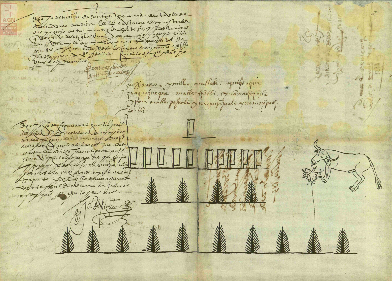cuacuahue (HJleg208exp2)
This example of iconography for an ox (cuacuahue) comes from a dispute in the area of Cuernavaca. The ox (or steer?) is shown as a black line drawing, with the body largely in profile, facing the viewer's left, and the animal's head with the face toward the viewer. The animal has a long tail and male genitals. He has long curving horns, and he is busy eating what appears to be a plant that comes to just below his chin.
Stephanie Wood
The iconography of the single ox stands for multiple animals. A Nahua lord complained that oxen (cuacuahueque) got into his cornfield and devoured his crop of 5,820 stalks of maize (toctli). He requested and won restitution in the form of somewhere between three pesos and seven pesos three tomines. Robert Haskett collaborated on this analysis. While the name of this animal seems to have the verb "cua" (to eat) in it, the cuacuahuitl at the root of the animal's name refers to horns. Juan José Batalla Rosado (El Arte de Escribir, 2018, 76) includes the cuacuahuitl ("cuerno de animal") in his list of visual loans. He finds the Matrícula de Huexotzinco to show the greatest degree of Western influence of all colonial codices.
Robert Haskett and Stephanie Wood
quaquahue
cuacuahue
Stephanie Wood
1583
Stephanie Wood
oxen, bueyes, steer
cuacuahue, ox, https://nahuatl.wired-humanities.org/content/cuacuahue
cuacuahui(tl), horns, https://nahuatl.wired-humanities.org/content/cuacuahuitl
toc(tli), maize stalks, https://nahuatl.wired-humanities.org/content/toctli
el buey
Single-page codex, Archivo General de la Nación, México, Ramo de Hospital de Jesús, legajo 208, expediente 2. Robert Haskett kindly captured the images from the manuscript and shared them with this project.
The Archivo General de la Nación (AGN), México, holds the original manuscript. This image is published here under a Creative Commons license, asking that you cite the AGN and this Visual Lexicon of Aztec Hieroglyphs.




